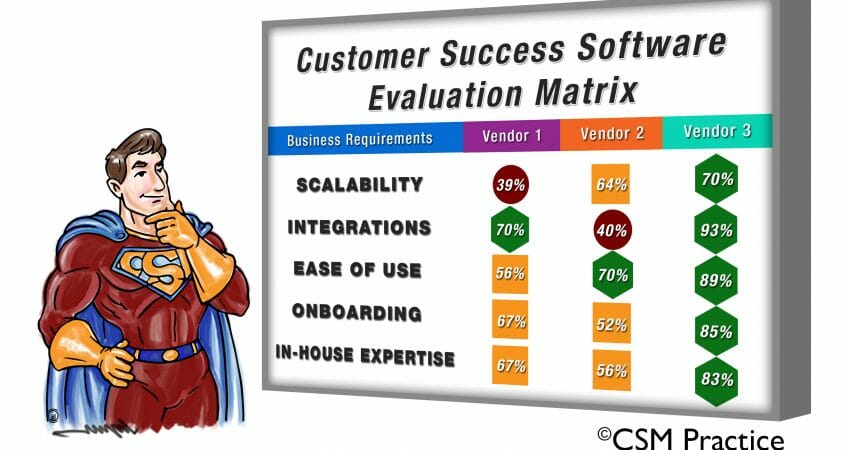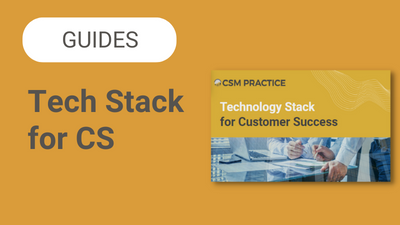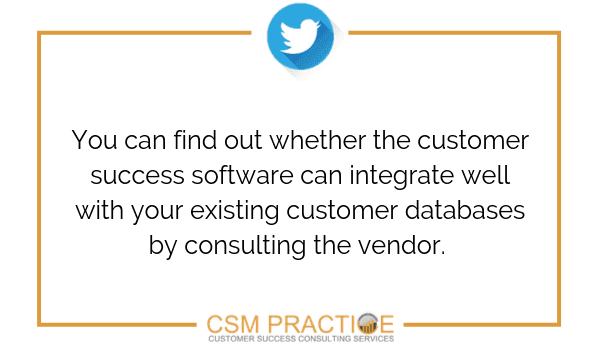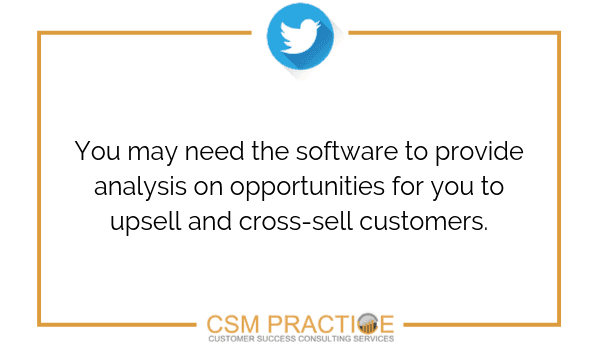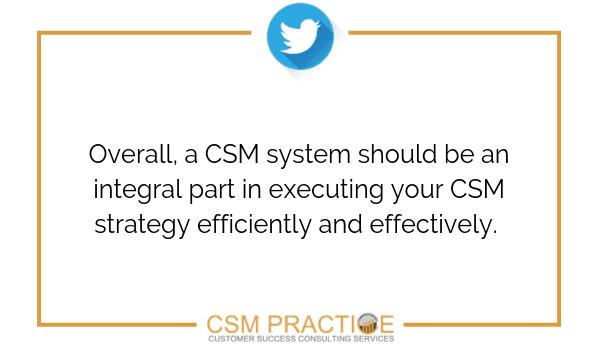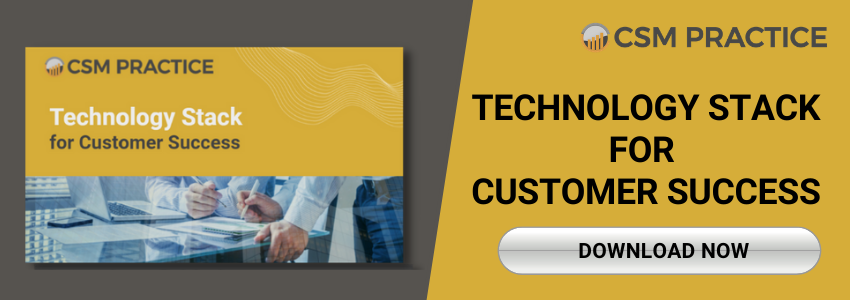The usage of Customer Success Management software is invaluable in business today. Such software helps the customer success team better understand your customers and effectively promote upsells and cross-sells. The goal of the customer success team is ultimately to help your customers get the maximum value out of your solution offerings, and this, in turn, leads to maximizing the lifetime value your company receives from its customers.
Choosing and implementing customer success software can be a challenging decision for many, especially those who never had a chance to use one. Regardless of previous experience, it’s important to take the right steps and considerations to thoughtfully decide whether to optimize your existing customer success system (even if it’s ‘just’ a spreadsheet) or implement a more robust one. In this blog, I’ll remove the confusion and guide you through the process I know works for many of our clients.
Here’s a list of steps to consider taking before deciding to optimize or invest in a new customer success system.
PART I: How to Choose a Customer Success System Like a Pro
1. Have a list of what you need from the CSM software
This is a bit basic, but worth remembering that not all customer success teams will experience the same level of satisfaction from the same customer success system. The choice you make has to specifically suit your team, and your engagement model (high touch or mainly tech touch), and will depend on your company’s lifecycle stage (startup or enterprise).
For example, a new customer success team is typically still learning what sticks and is still trying to understand its customer’s desired outcome. At this point, the customer success team will not necessarily need to focus on upsells and cross-sells or a scalable engagement model (too few customers typically, so not worth the effort). Rather, the customer success team will be more interested in creating a central place to track client communication and if possible, monitor usage patterns. At a different level, the company will focus on building customer loyalty and creating client success.
In other words, what you require from customer success software depends on your current business needs. To make the best decision, you should write all these down before you start to shop for one. I’ll start with a few tips on how to choose a customer success software and then explain how to implement one. If you already made up your mind about which customer success solution you are going to acquire (or already have but not fully implemented it yet) – go ahead and skip to the second portion of this blog where I’ll expand on how to get the most out of your customer success system implementation.
2. Inspect your options before making a final decision
Granted, you may fail to find a single customer success solution that exactly matches the list of the current requirements. However, before making your final decision, you need to find out what the market has. There are currently a few customer success solutions to select from on the market. Find out if the software you intend to purchase can provide the customer analytics you need, and whether it can integrate with other key customer systems you’re currently using. Then you can compare and score customer success software solutions before making your decision. Make sure you assign a higher weight to requirements that are important and a lower weight to the ones that are ‘nice to have’ before calculating your final score. You can find many web pages dedicated to helping you with your research, take this one, for example, from TrustRadius.
3. Research previous customers’ experiences
Before investing in a customer success solution, request that the marketing or sales team get introduced to existing clients and inquire about their experiences implementing, using, and maintaining the solution. For example, if you are considering investing in Gainsight, as your software of choice, you may want to search for online reviews or become a member of the Gainsight online community to read what their customers say.
For other customer success solutions, such as ClientSuccess or Amity you can simply ask to be introduced to existing customers. Ask them whether they were unsatisfied with the level of service or breadth of functionality. Their answers will help guide your decision on whether or not to be purchasing the software. As a rule of thumb, a good software vendor should be able to provide you with at least 3 customer references.
 4. Consider the integration of other customer data points
4. Consider the integration of other customer data points
It is too common to find that you purchased a CSM system that will not integrate well with your other systems such as your company’s CRM system, marketing, services, support, surveys, eLearning, advocacy, and billing. The hardest integration that I see with clients is with the user database if one exists.
You can find out whether the customer success software can integrate well with your existing customer databases and tools by consulting the vendor. Alternatively, you can find out from existing customers of the software. If you have multiple databases you’re planning to pull data from, or if the data integration is expected to be complex – allow enough time to launch, plan for a multi-phase approach to accelerate the first value delivered, and finally, seriously consider working with a consulting firm to help you implement the solution.
5. Consider the usability of the software
The customer success software should be usable by your company’s customer success managers to prioritize their daily activities, document account plans, and facilitate the detection of customer health issues, etc. One thing to consider is whether your customer success team wishes to access the system through their CSM system or as a stand-alone. If your company and customer success team are already using Salesforce, you may want to carefully consider the integration of the customer success software with that platform and the ability to enter and report data to and from the CRM solution. Gainsight was built on the Salesforce platform as a Salesforce application, making the integration with Salesforce objects completely native. This means, no synchronization lag or data load scripts are required to leverage data in Salesforce. Other customer success solutions such as ClientSuccess or Amity are not built on the Salesforce platform but may offer built-in integrations with other important customer data sources.
 6. Consider the analysis you need
6. Consider the analysis you need
If you are working at a start-up software company, you will likely be more interested in the adoption and usage patterns of various features. If you do not have access to your usage data, you would most likely want to focus on data related to support, surveys, online community, advocacy, billing, etc. At a higher level, you may want the customer management software to analyze customer data by customer attributes, such as segments, tiers, industry, lifetime in days, health score, etc. Similarly, you may need the software to provide data analysis that would help discover upsell and cross-sell opportunities more efficiently. Generally, most companies will increase their retention rates by getting customer survey feedback in the hands of customer-facing teams in a timely manner. A robust customer success platform should be able to help provide this information to help reduce churn and improve customer loyalty.
7. Understand your engagement model
The customer success software should be able to cater to support your customer success programs for any of your client segments. An efficient client segmentation allows your customer success team to dedicate the proper level of attention and resources, which would typically differ from one segment to the next. Companies with mainly high-value customers should consider adopting a customer success software that accommodates account planning, integrates well with your CRM system, and promotes transparency and collaboration among various customer-facing team members. This type of customer success plan is typically referred to as a high-touch engagement model. The related customer management software that supports this engagement model is typically used by companies with an average annual recurring revenue of over 100,000 USD. Examples of customer success software solutions that support this high-touch engaging model are Gainsight, Amity, Preact, Bluenose, Totango, ClientSuccess, Natero, and ChurnZero.
Low touch engagement models (also called “Just in time”) are typically used by companies with a lower average annual recurring revenue (for example 5,000 and 100,000 USD). Companies with a much lower average annual recurring revenue are best served by customer success tools that support scalable customer communication. These tools promote customer campaigns, online communities, advocacy, surveys, and eLearning.
PART II: The Secrets to Successfully Implementing a Customer Success System
1. Appoint an internal power user and system administrator
Ideally, one of your customer success managers should be comfortable working with the new CSM software and take the role of the power user or even the CSM system administrator. I recommend including them in the decision-making process of choosing your next customer success system. If you haven’t identified your system administrator or power user yet, invest sufficient time and resources in training them on how to administer the software as soon as possible. Otherwise, it won’t matter how much you have invested in purchasing and implementing the system. If your new Customer Success software cannot be well maintained on an ongoing basis, it will not deliver the expected results.
Your CSM system administrator and power users should not only be tech-savvy but should also be able to interpret customer data correctly and lead the team to better client success processes on an ongoing basis. Identifying the right people and assigning them to be responsible for maintaining the CSM software will also mean that technical issues will be quickly resolved without delay. This role is critical to the successful implementation of a customer success solution. If you don’t have enough in-house resources to be dedicated to the maintenance of your CSM solution on an ongoing basis, consider your outsourcing options. CSM Practice offers Gainsight AdminPro services for companies who wish to have a Gainsight Administrator on a part-time basis. The main benefit of outsourcing your Gainsight administrator is having a resource available to perform a range of tasks without impacting your bandwidth. All of our consultants are CSM certified, Salesforce certification, and Gainsight Administrator trained.
2. Identify and collaborate with your Executive Sponsor
Your executive sponsor is in charge of leading new projects, communicating changes, and ensuring teams work together in order to implement changes successfully. In order for this to happen, you need to collaborate with the sponsor when it comes to implementing the software. If not, the sponsor may not successfully lead the new changes and the software change may prove unsuccessful. There’s a great article on Prosci that can help you figure out how to leverage your executive sponsor.
3. Invest in training your CSMs on how to use the software
Customer Success systems have evolved a great deal since I started working in this space. Most CSM systems have various modules that cater to various business needs a CSM team might develop per each of their customer segments. It, therefore, comes as no surprise to find that many users fail to completely make use of all the features available in their customer success software. Implementing new software should call your company to train your customer success team. I find that in many cases, user training is often offered by the software company once (typically around the initial go-live date) or not at all. Poor training and a lack of full understanding of all the features your CSM solution of choice has to offer will lead to delays and less-than-optimum levels of customer success processes.
It is also important that you provide the necessary amount of time and resources for training users on how to implement the software. The most effective training sessions I’ve helped set up were done through a “train the trainer” methodology. This approach has been adopted by Gainsight early on, and I highly recommend taking advantage of this powerful framework to help your power user develop and present the training to the other team members on an ongoing basis. This course and others like it can be found by clicking here. If you are considering investing in customer success software such as ClientSuccess, Totango or Amity, you definitely want to find out about their training offerings. As about live (onsite or online) training options, whether they have pre-recorded ‘how to’ videos and check out their online knowledge base website.
Summary
- The CSM system you need is based on a few factors, namely, what your customer success team requires to make their jobs easier.
- The goals of the business should influence which CSM system you choose. There is no point in getting a standard CSM system if your business intends to grow, and you expect to scale your Customer Success team.
- Do your research and learn how different CSM solutions integrate with various databases and systems in order to avoid data integration challenges in the future.
- Ensure that not only does at least one Customer Success manager know how to use your CSM system of choice but that the other team members have access to what they need and keep the system updated and organized.
Overall, a customer success platform should be an integral part of your plan for executing your Customer Success strategy – efficiently and effectively. An investment in CSM software ensures that your customer success managers are organized, and proactive and have all the most important information about their book of business in one place and in a timely manner.
To ensure you make the right decision about which CSM system to get, you need to do your research. If you feel like you need help in getting the most out of your current customer success system, please CLICK HERE or call 408-663-6267 before you decide to replace it (or get rid of it). Nine out of ten times, we can help you get a lot more value out of it and make good on your vision to incorporate the solution to empower your CSM team. Alternatively, we’ve created a checklist that you can use to determine whether your CSM needs to be upgraded or not. To get a grasp on how your CSM system is doing now (or even if now is the time to invest in one) then CLICK HERE.
Lastly, please take an active role in your customer success community and share what customer success tools have you used and what your recommendations are for other members of the community. Leave a comment below and remember to share this blog with other customer success managers.

